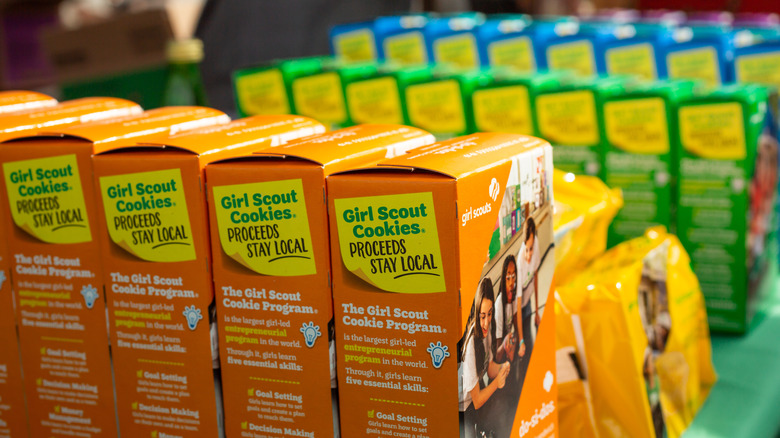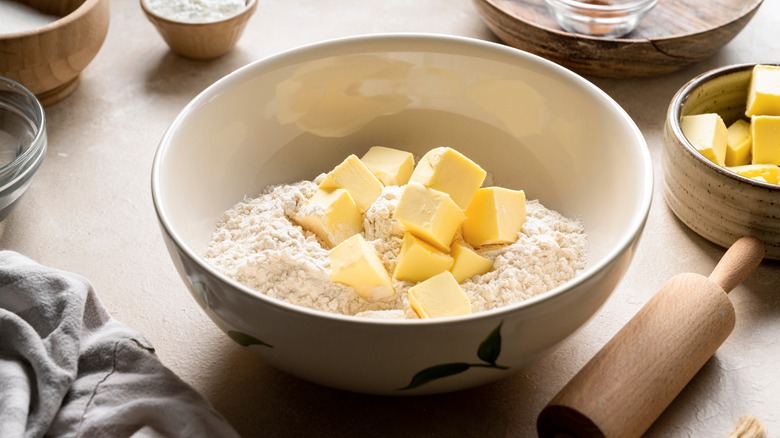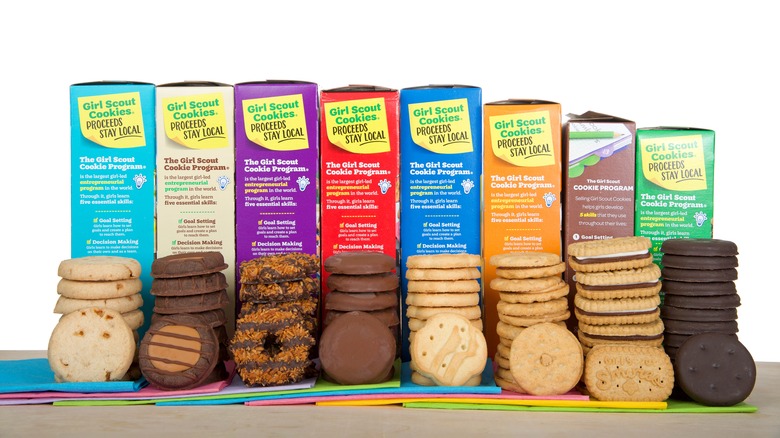The Very First Girl Scout Cookies Were Actually Baked By Hand
Girl Scout Cookie season is officially upon us. Badge-adorned young people have already begun selling boxes of the coveted baked goods in certain parts of the country, with other states on deck in the coming months. If you're unsure where your locale stands, you can search for the dates and locations of your nearest cookie booths on the Girl Scouts website.
From old standbys like Thin Mints, Trefoils, and Samoas, to newcomers like salted caramel Adventurefuls and 2023's Raspberry Rallies, there's something about the line of treats that compels us to dole out more cash than we would for the average cookie. In Oregon and Southwest Washington, the cost of a box of Girl Scout Cookies will go up from $5 to $6 in 2023, which, at least at the time of the OregonLive report, is pricier on average than a gallon of gas in the Beaver State.
We digress. Anyone who makes a tradition of buying their favorite flavor each year knows that the cookies are worth the price. One thing's for sure: Girl Scout Cookies would be way more expensive if they were made by hand. Once upon a time, they actually were.
Sugar cookies made to order
From 1917 all the way through the 1920s, before Girl Scout Cookies were mass-produced in factories, the beloved treats were baked by busy flocks of Girl Scout hands. According to Reader's Digest, the original Girl Scout Cookie model had troops making lots and lots of sugar cookies, tucking them into wax-paper bags, and selling them door-to-door alongside parent volunteers. Back then, the cookies only set customers back $.25 to $.35 per dozen.
According to Girl Scouts, the Mistletoe Troop in Muskogee, Oklahoma started the trend when they sold made homemade cookies in the local high school cafeteria as part of a "service project." Adults at home clearly felt left out, giving rise to a cookie-canvasing revolution. The recipe was published in a 1922 issue of "The American Girl" magazine and appears on the blog Old School Pastry. It reads, "Attention Scouts! March forward! Bake! Sell!" The recipe calls for butter, sugar, milk, eggs, vanilla, flour, and baking powder, making for a pretty foolproof sugar cookie. The dough is rolled thin, sprinkled with sugar, and baked to perfection by scouts "both short and tall."
Philly goes commercial
In 1933, after a decade of door-to-door cookie sales went by, the Girl Scouts of Greater Philadelphia Council decided to sell the baked goods in local gas and electric company windows, all in the name of raising funds for troop activities. In 1934, the demand for cookies was higher than ever, prompting the troop to turn to commercially made cookies, per the Girl Scouts of Greater Philadelphia Council. The Girl Scout Federation of Greater New York followed suit the following year. By 1936, the Girl Scouts as a national body decided to license its own cookies with commercial bakers.
Trefoils were a popular early hit, but Girl Scouts historian Kelly Parisi tells Time that Thin Mints have always been the ultimate favorite. The chocolate-covered, peppermint-infused treats were released in 1939 as "Cooky-Mints." They were later referred to as "Chocolate Mint," followed by "Thin Mint," followed by "Cookie Mint," then back to "Chocolate Mint," then to "Thin Mints," then to "Thin Mint" (singular). Finally, the federation reverted back to the plural "Thin Mints." Parisi also asserts that Girl Scout Cookies — Thin Mints in particular — are best enjoyed straight from the freezer.


